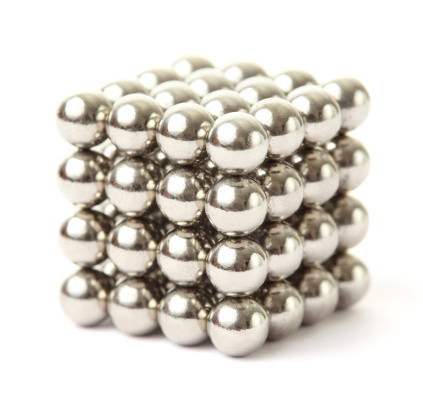Editor’s Note: This holiday season, parents of young children can thank a group of doctor advocates for making the season safer. Dr. Bryan J. Rudolph of Albert Einstein College of Medicine and Montefiore Medical Center describes efforts that resulted in drastically reducing the number of dangerous magnetic toys in the marketplace.
As practicing pediatric gastroenterologists at The Children’s Hospital at Montefiore, my colleagues and I remove a fair number of esophageal and intestinal foreign bodies (i.e., things kids accidentally swallow).

Magnetic balls marketed to adults but dangerous and accessible to children.
A couple of years ago, several physicians across the country began noticing serious injuries in children who swallowed high-powered magnets. The issue was raised in an email forum for pediatric gastroenterologists and the response was overwhelming. There were hundreds of cases—throughout the world, as we later learned—that many of us had thought were isolated incidents. An avalanche of emails quickly convinced us otherwise.
Fatal Attraction
It turns out that we were seeing the effect of Buckyballs, Neocubes and similar products. These rare-earth neodymium magnets are small, roughly 5 mm in diameter (2.5 times the size of a pinhead), and come in large sets (most commonly of 216). They are marketed to adults as stress relievers or desk toys. Unfortunately, they are easily accessible to young children. Because they are much more powerful than standard refrigerator magnets, they are extremely dangerous if ingested.
Inside the body, two or more magnets will come together and trap any organ—stomach, intestine, etc.—in their path. This can cause intestinal perforations, infections or even death. One child in Louisiana lost the majority of his small intestine after swallowing several magnets; he is now fed through an IV line and will likely need an intestinal transplant. A 19-month-old girl in Ohio recently died. Thousands more sought emergency care or underwent invasive procedures as a result of magnet ingestions.
See what ingested magnets look like in the intestines.
A Time for Action
When the severity of the problem first became apparent, our professional group responded. As a member of the advocacy committee for the North American Society of Pediatric Gastroenterology, Hepatology and Nutrition (NASPGHAN), I became involved in these efforts. I attended two meetings at the Consumer Product Safety Commission (CPSC), testifying once; lobbied Congress; and spoke at a press conference in 2012 with Commissioner Adler of the CPSC on behalf of NASPGHAN. I was interviewed by major media outlets and even by a reporter from New Zealand, whose articles helped get high-powered magnets banned in that country.
Success, at Last!
Though the subject was previously on the CPSC’s radar, NASPGHAN’s advocacy efforts undoubtedly helped spur aggressive regulatory action. And after more than two years of policy proposals, voluntary recalls, legal wrangling and public relations campaigns, two weeks ago the CPSC commissioners voted 4 to 0 to prohibit these products from being sold in the U.S.
Advocacy for Dummies
I can’t help being a little bit surprised by the whole process: that I became so involved, that my professional society made advocacy so easy and relatively effortless, that policymakers were so receptive to our concerns, that it can take years definitively to ban a clearly dangerous product—and that, well, we actually made a difference.
I have learned how much weight our collective voices can carry and that good policymakers need us just as much as we need them. And for the first time in a long time, I am hopeful. I am hopeful that in these turbulent times, we as healthcare providers can effect important change. We can use our knowledge and experience to advocate successfully for our patients, ourselves and our profession. In short, we can make healthcare what we once thought it could be.
Oh, and if you have any high-powered magnets lying around at home, please throw them away. Now.

